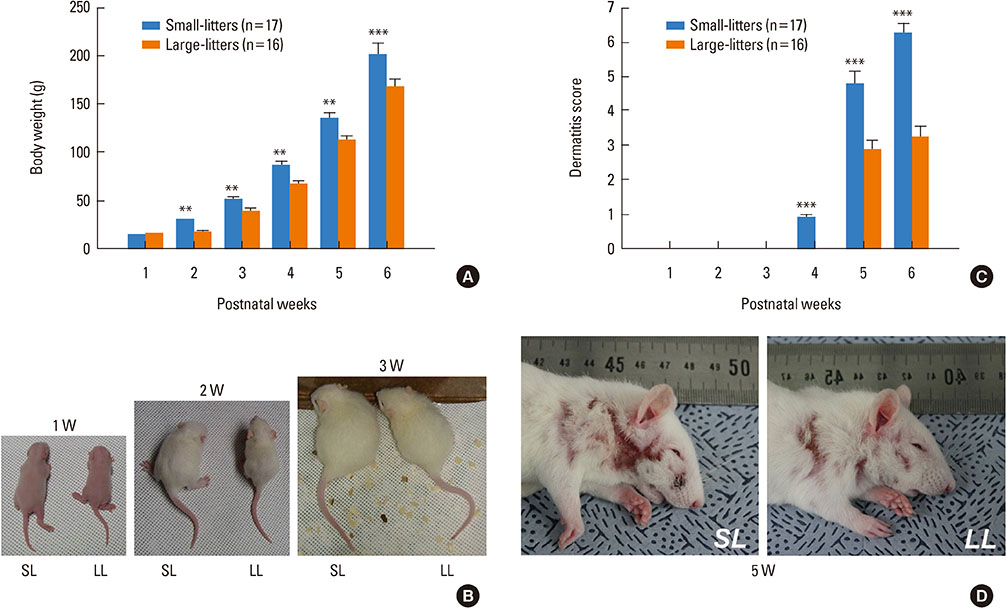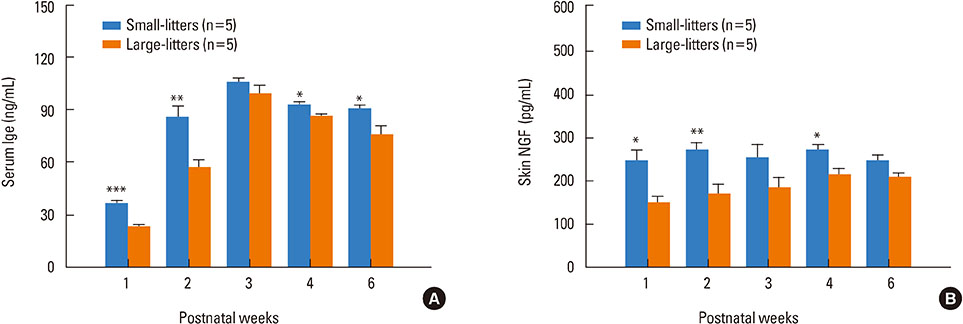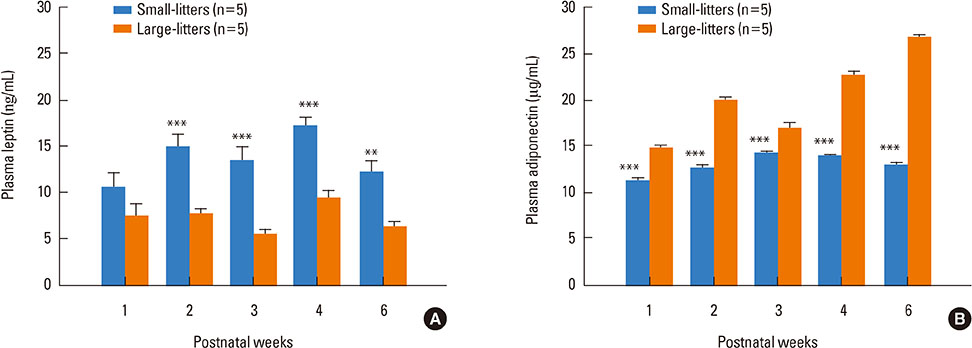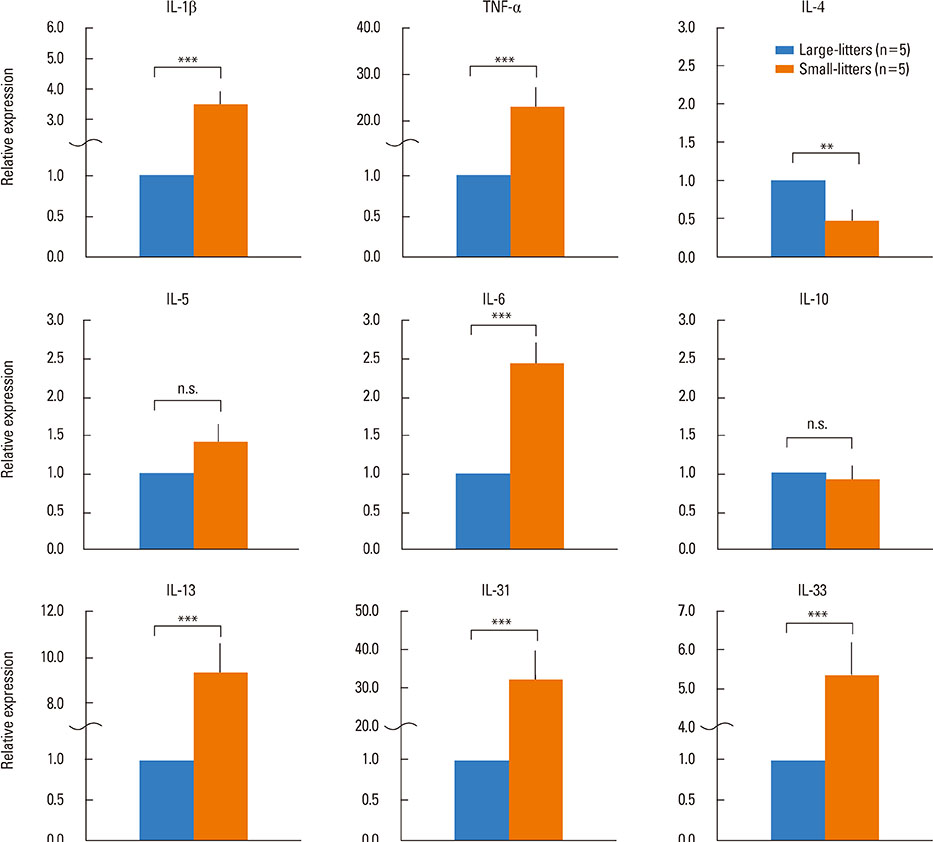Allergy Asthma Immunol Res.
2015 Jan;7(1):69-75. 10.4168/aair.2015.7.1.69.
Juvenile Obesity Aggravates Disease Severity in a Rat Model of Atopic Dermatitis
- Affiliations
-
- 1Neuroscience Research Institute & Department of Physiology, Korea University College of Medicine, Seoul, Korea. hsna@korea.ac.kr, skback@korea.ac.kr
- KMID: 2260154
- DOI: http://doi.org/10.4168/aair.2015.7.1.69
Abstract
- PURPOSE
There is increasing epidemiological evidence of an association between childhood obesity and atopic dermatitis, but little is known about the underlying mechanism(s). In the present study, we used a rat model of atopic dermatitis to assess whether juvenile obesity, induced by reduction of litter size, aggravated the signs of atopic dermatitis and, if so, whether this aggravation was associated with changes in plasma concentration of adipokines, such as leptin and adiponectin.
METHODS
Dermatitis was induced by neonatal capsaicin treatment. Body weight, dermatitis score, serum IgE, skin nerve growth factor (NGF), serum leptin and adiponectin, and cytokine mRNA expression in the skin lesion were compared between small (SL, 5 pups) and large litters (LL, 15 pups).
RESULTS
The body weight of juvenile rats up to 6 weeks of age was significantly heavier in the SL group, compared with those in the LL group. The SL group showed more robust development of dermatitis, and higher levels of serum IgE and skin NGF than the LL group. Additionally, the SL group demonstrated higher levels of leptin and pro-inflammatory cytokine mRNA but lower levels of adiponectin than the LL group.
CONCLUSIONS
These results suggest a causal link between a decrease in immunological tolerance, induced by juvenile obesity, and aggravation of atopic dermatitis.
MeSH Terms
Figure
Cited by 1 articles
-
Obesity is a risk factor for allergic rhinitis in children of Wuhan (China)
Yang Lei, Huang Yang, Long Zhen
Asia Pac Allergy. 2016;6(2):101-104. doi: 10.5415/apallergy.2016.6.2.101.
Reference
-
1. Eichenfield LF, Hanifin JM, Beck LA, Lemanske RF Jr, Sampson HA, Weiss ST, Leung DY. Atopic dermatitis and asthma: parallels in the evolution of treatment. Pediatrics. 2003; 111:608–616.2. Asher MI, Montefort S, Björkstén B, Lai CK, Strachan DP, Weiland SK, Williams H. ISAAC Phase Three Study Group. Worldwide time trends in the prevalence of symptoms of asthma, allergic rhinoconjunctivitis, and eczema in childhood: ISAAC Phases One and Three repeat multicountry cross-sectional surveys. Lancet. 2006; 368:733–743.3. Maziak W, Behrens T, Brasky TM, Duhme H, Rzehak P, Weiland SK, Keil U. Are asthma and allergies in children and adolescents increasing? Results from ISAAC phase I and phase III surveys in Münster, Germany. Allergy. 2003; 58:572–579.4. Rokholm B, Baker JL, Sørensen TI. The levelling off of the obesity epidemic since the year 1999--a review of evidence and perspectives. Obes Rev. 2010; 11:835–846.5. Kundi M. Obesity and atopy: what is the relationship? Int Arch Allergy Immunol. 2010; 153:321–322.6. Nagel G, Koenig W, Rapp K, Wabitsch M, Zoellner I, Weiland SK. Associations of adipokines with asthma, rhinoconjunctivitis, and eczema in German schoolchildren. Pediatr Allergy Immunol. 2009; 20:81–88.7. Machura E, Szczepanska M, Ziora K, Ziora D, Swietochowska E, Barc-Czarnecka M, Kasperska-Zajac A. Evaluation of adipokines: apelin, visfatin, and resistin in children with atopic dermatitis. Mediators Inflamm. 2013; 2013:760691.8. Hersoug LG, Linneberg A. The link between the epidemics of obesity and allergic diseases: does obesity induce decreased immune tolerance? Allergy. 2007; 62:1205–1213.9. Back SK, Jeong KY, Li C, Lee J, Lee SB, Na HS. Chronically relapsing pruritic dermatitis in the rats treated as neonate with capsaicin; a potential rat model of human atopic dermatitis. J Dermatol Sci. 2012; 67:111–119.10. Wurtman JJ, Miller SA. Effect of litter size on weight gain in rats. J Nutr. 1976; 106:697–701.11. Guler N, Kirerleri E, Ones U, Tamay Z, Salmayenli N, Darendeliler F. Leptin: does it have any role in childhood asthma? J Allergy Clin Immunol. 2004; 114:254–259.12. Sood A, Ford ES, Camargo CA Jr. Association between leptin and asthma in adults. Thorax. 2006; 61:300–305.13. Asayama K, Hayashibe H, Dobashi K, Uchida N, Nakane T, Kodera K, Shirahata A, Taniyama M. Decrease in serum adiponectin level due to obesity and visceral fat accumulation in children. Obes Res. 2003; 11:1072–1079.14. Weiss R, Dziura J, Burgert TS, Tamborlane WV, Taksali SE, Yeckel CW, Allen K, Lopes M, Savoye M, Morrison J, Sherwin RS, Caprio S. Obesity and the metabolic syndrome in children and adolescents. N Engl J Med. 2004; 350:2362–2374.15. Shore SA, Terry RD, Flynt L, Xu A, Hug C. Adiponectin attenuates allergen-induced airway inflammation and hyperresponsiveness in mice. J Allergy Clin Immunol. 2006; 118:389–395.16. Mihara K, Kuratani K, Matsui T, Nakamura M, Yokota K. Vital role of the itch-scratch response in development of spontaneous dermatitis in NC/Nga mice. Br J Dermatol. 2004; 151:335–345.17. Widdowson EM, Mc CR. Some effects of accelerating growth. I. General somatic development. Proc R Soc Lond B Biol Sci. 1960; 152:188–206.18. Knittle JL, Hirsch J. Effect of early nutrition on the development of rat epididymal fat pads: cellularity and metabolism. J Clin Invest. 1968; 47:2091–2098.19. Wang Y, Lobstein T. Worldwide trends in childhood overweight and obesity. Int J Pediatr Obes. 2006; 1:11–25.20. Wüthrich B. Clinical aspects, epidemiology, and prognosis of atopic dermatitis. Ann Allergy Asthma Immunol. 1999; 83:464–470.21. Han JC, Lawlor DA, Kimm SY. Childhood obesity. Lancet. 2010; 375:1737–1748.22. Ouchi N, Parker JL, Lugus JJ, Walsh K. Adipokines in inflammation and metabolic disease. Nat Rev Immunol. 2011; 11:85–97.23. Kim SH, Sutherland ER, Gelfand EW. Is there a link between obesity and asthma? Allergy Asthma Immunol Res. 2014; 6:189–195.24. Chen Y, Dales R, Krewski D, Breithaupt K. Increased effects of smoking and obesity on asthma among female Canadians: the National Population Health Survey, 1994-1995. Am J Epidemiol. 1999; 150:255–262.25. Guerra S, Sherrill DL, Bobadilla A, Martinez FD, Barbee RA. The relation of body mass index to asthma, chronic bronchitis, and emphysema. Chest. 2002; 122:1256–1263.26. Shaheen SO, Sterne JA, Montgomery SM, Azima H. Birth weight, body mass index and asthma in young adults. Thorax. 1999; 54:396–402.27. Cassol VE, Rizzato TM, Teche SP, Basso DF, Centenaro DF, Maldonado M, Moraes EZ, Hirakata VN, Solé D, Menna-Barreto SS. Obesity and its relationship with asthma prevalence and severity in adolescents from southern Brazil. J Asthma. 2006; 43:57–60.28. Bråbäck L, Hjern A, Rasmussen F. Body mass index, asthma and allergic rhinoconjunctivitis in Swedish conscripts-a national cohort study over three decades. Respir Med. 2005; 99:1010–1014.29. Yoo S, Kim HB, Lee SY, Kim BS, Kim JH, Yu JH, Kim BJ, Hong SJ. Association between obesity and the prevalence of allergic diseases, atopy, and bronchial hyperresponsiveness in Korean adolescents. Int Arch Allergy Immunol. 2011; 154:42–48.30. Lumeng CN, Saltiel AR. Inflammatory links between obesity and metabolic disease. J Clin Invest. 2011; 121:2111–2117.31. Fantuzzi G. Adipose tissue, adipokines, and inflammation. J Allergy Clin Immunol. 2005; 115:911–919.32. Wang B, Trayhurn P. Acute and prolonged effects of TNF-α on the expression and secretion of inflammation-related adipokines by human adipocytes differentiated in culture. Pflugers Arch. 2006; 452:418–427.33. Wong CK, Cheung PF, Lam CW. Leptin-mediated cytokine release and migration of eosinophils: implications for immunopathophysiology of allergic inflammation. Eur J Immunol. 2007; 37:2337–2348.34. Vieira VJ, Ronan AM, Windt MR, Tagliaferro AR. Elevated atopy in healthy obese women. Am J Clin Nutr. 2005; 82:504–509.35. Xu B, Jarvelin MR, Pekkanen J. Body build and atopy. J Allergy Clin Immunol. 2000; 105:393–394.36. Porter M, Wegienka G, Havstad S, Nageotte CG, Johnson CC, Ownby DR, Zoratti EM. Relationship between childhood body mass index and young adult asthma. Ann Allergy Asthma Immunol. 2012; 109:408–411.e1.37. Ouchi N, Kihara S, Funahashi T, Matsuzawa Y, Walsh K. Obesity, adiponectin and vascular inflammatory disease. Curr Opin Lipidol. 2003; 14:561–566.38. Kosteli A, Sugaru E, Haemmerle G, Martin JF, Lei J, Zechner R, Ferrante AW Jr. Weight loss and lipolysis promote a dynamic immune response in murine adipose tissue. J Clin Invest. 2010; 120:3466–3479.39. Ouchi N, Kihara S, Funahashi T, Nakamura T, Nishida M, Kumada M, Okamoto Y, Ohashi K, Nagaretani H, Kishida K, Nishizawa H, Maeda N, Kobayashi H, Hiraoka H, Matsuzawa Y. Reciprocal association of C-reactive protein with adiponectin in blood stream and adipose tissue. Circulation. 2003; 107:671–674.40. Ip S, Chung M, Raman G, Chew P, Magula N, DeVine D, Trikalinos T, Lau J. Breastfeeding and maternal and infant health outcomes in developed countries. Evid Rep Technol Assess (Full Rep). 2007; 1–186.
- Full Text Links
- Actions
-
Cited
- CITED
-
- Close
- Share
- Similar articles
-
- Measurement of Atopic Dermatitis Disability
- The Effect of Antigen Sensitization and Development of Respiratory Allergy Disease on Severity of Atopic Dermatitis
- Associations of Atopic Dermatitis With Obesity and Unmarried Status in Young Adults: Evidence for Atopic Dermatitis as a Life-Style Disorder With High Social Impact
- A Study on the Relationship of the Severity of Atopic Dermatitis, Serum IgE and IFN-gamma
- A Study on the T Lymphocyte Subsets and Serum IgE in Patients with Atopic Dermatitis





